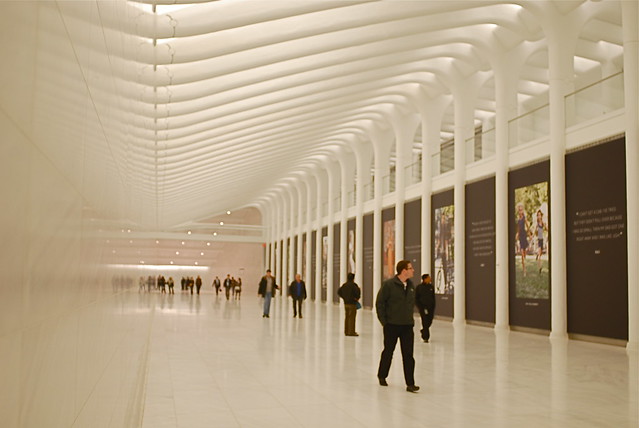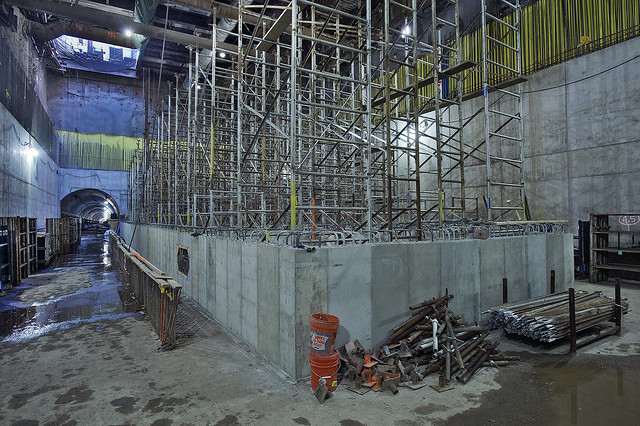The target date to wrap the MTA’s installation of communications-based train control along Flushing Line has been delayed six months until mid-2017, the agency said in documents released this weekend. As part of the update to the Capital Program Oversight Committee, the MTA noted that the $550 million project remains on budget, but due, in part, to complications from Sandy, the project’s substantial completion date has been pushed back from the fourth quarter of 2016 to the second quarter of 2017.
According to the documents, two issues could further impact this date. The first concerned the availability of test tracks for the CBTC-enabled R188s. These cars were due to be tested on the Rockaway Test Track, but this stretch of railbed was damaged during Sandy. The delay in repairing the test track has pushed back the date for final delivery of the R188s from February 2016 to August 2016.
Second, the MTA fingers “G.O. Availability” as a concern. As CBTC work means many weekends without 7 train service into and out of Queens, the agency has been working with community leaders along the Flushing Line to better plan outages. As the Board materials say, though, “if track outages for this project are delayed/denied, the project’s milestones will be delayed.” In other words, if the MTA can’t schedule G.O.’s, it can’t perform the work on time. I’ll continue to follow this story, but for now, the expected completion date is slipping.

 After years of starts and stops, seemingly endless pilot programs, a clean slate and a vow to move forward with something by 2020, the MTA’s plan to replace the MetroCard with a next-generation fare payment technology may finally be moving forward. In what can best be described as baby steps, the MTA, in a document to be presented to the Board’s Capital Program Oversight Committee later this week, has unveiled some thoughts on the MetroCard’s eventual replacement. It will be an account-based system relying on open architecture and contactless technology based upon payment industry standards, and it should arrive some time around 2020.
After years of starts and stops, seemingly endless pilot programs, a clean slate and a vow to move forward with something by 2020, the MTA’s plan to replace the MetroCard with a next-generation fare payment technology may finally be moving forward. In what can best be described as baby steps, the MTA, in a document to be presented to the Board’s Capital Program Oversight Committee later this week, has unveiled some thoughts on the MetroCard’s eventual replacement. It will be an account-based system relying on open architecture and contactless technology based upon payment industry standards, and it should arrive some time around 2020.










 (Rockaway Park Shuttle)
(Rockaway Park Shuttle)


 It’s time once again for another new episode of the Second Ave. Sagas’ podcast “The Next Stop Is…” This week, Eric Brasure and I discuss the
It’s time once again for another new episode of the Second Ave. Sagas’ podcast “The Next Stop Is…” This week, Eric Brasure and I discuss the  It’s going to take some time to get used to the idea of Mayor Bill de Blasio. It’s the first time New York City has had a new chief executive since 2001, and times, for better or worse, sure have changed. In a sense, with Michael Bloomberg on the way out, de Blasio will have a clean slate, but that doesn’t mean he can’t learn from and adopt the good ideas of his predecessor. Particularly in the transit and transportation realms, de Blasio would be wise to take a page from the Bloomberg playbook.
It’s going to take some time to get used to the idea of Mayor Bill de Blasio. It’s the first time New York City has had a new chief executive since 2001, and times, for better or worse, sure have changed. In a sense, with Michael Bloomberg on the way out, de Blasio will have a clean slate, but that doesn’t mean he can’t learn from and adopt the good ideas of his predecessor. Particularly in the transit and transportation realms, de Blasio would be wise to take a page from the Bloomberg playbook.